.

Growing Cannabis With Sustainable Practices
No matter what scale you’re working at, cannabis cultivation consumes a lot of energy and water, and it produces waste that needs to be managed responsibly. Luckily, there are many simple steps you can take to make your growing space more sustainable, all of which will allow you to minimise your impact on the environment.
You’re only a few easy steps away from growing environmentally conscious cannabis.
Contents:
To produce top-shelf buds, cannabis plants need natural light (or its artificial equivalent), steady hydration, and consistent nutrition. Meeting these demands requires a lot of electricity and water, and the process produces waste that negatively impacts the local environment.
Luckily, there are a few simple ways you make your cannabis growing operation sustainable while reducing your environmental footprint in turn.
What Is Sustainable Cannabis Growing?
In the US, cannabis cultivation uses up 1% of the nation’s electricity[1]. By some estimates, the energy legal grow houses use to produce one kilogram of flower is equivalent to driving a car across the entire country seven times. In terms of cash, the energy bill for legal US cannabis clocks in at around $6 billion. Considering this, clearly there’s a need for enhanced energy efficiency in the growing process.
You might be thinking that sustainable growing only really matters to large-scale, commercial growers. But even in small-scale setups, the cost of running high-powered grow lights, exhausts, and fans can add up quickly. Plus, small-scale growers still need nutrients, and the products containing them create runoff that’s toxic to the environment.
That’s where sustainable growing comes into play. The legalization of cannabis in places like Canada has shown us that growing weed takes its toll on the environment. Luckily, a growing community of people and businesses are working to make growing cannabis “green” in a whole other way.
Sustainable cannabis growing is all about reducing the impact your grow has on the environment. This can include anything from introducing alternative power sources for your lights, to using exclusively all-natural fertilisers. Whether you’re indoors or outdoors, a commercial grower or a small-time gardener, all these adjustments are in your reach.
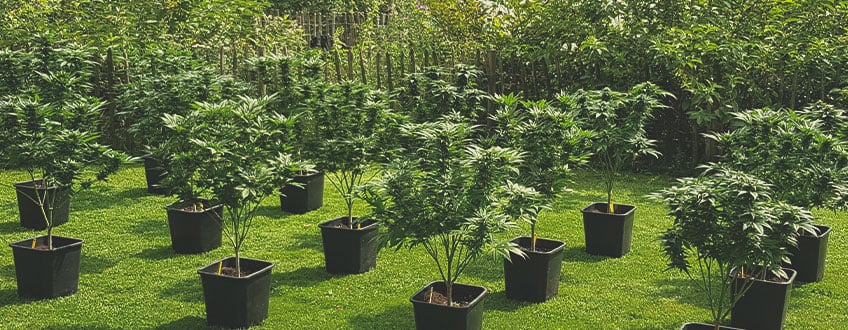
The 4 Pillars of Sustainable Cannabis Cultivation
To be more specific, there are four main aspects of cannabis cultivation where growers can apply sustainable practices.
1. Energy Consumption of Lights
Cannabis loves the sun; the more light a plant gets, the more flower it yields. Hence, indoor growers need to invest in powerful light sources to ensure their plants can grow to their full potential. In general, growers will use at least 50–80 watts of light per square foot of canopy. Many, though, will end up using higher wattage setups to maximise their yields.
Obviously, running this kind of powerful lighting uses a lot of electricity. For example, running a small 250W light for 18 hours a day for four weeks of veg, then 12 hours per day for eight weeks of flowering, requires roughly 315 kilowatt-hours of electricity. That might not sound like much, but keep in mind that:
- Most indoor growers opt for at least 300W grow lights.
- Most indoor growers crop multiple harvests per year.
Also, it’s important to note that most grow lights (even LEDs) give off heat when running for prolonged periods. To mediate that, growers typically instal fans, exhaust systems, and air conditioning systems to control their grow room’s climate. That earlier calculation doesn’t account for this energy cost, and you can bet it adds up.
2. Energy Consumption for Climate Control
Just like cannabis loves light, it also loves warm temperatures and moderate humidity. Accordingly, indoor growers should invest in equipment to monitor their grow room climate and adjust it as needed.
In most cases, the climate control equipment you’ll need in your grow room includes:
- An exhaust system to draw hot air out of your room and replace it with fresh air.
- Fans to keep air circulating around the room.
Note: Depending on the size of your grow room, the number of plants you’re growing, and your location, you may also need to invest in an air conditioning system and humidifier. However, most small-scale personal setups don’t warrant this equipment.
Just like with grow lights, running this kind of equipment takes a lot of energy. Your exhaust fan, for example, will be running 24 hours per day, and generally consumes about 30W of electricity (this obviously varies among models).
Your other fans will also be on constantly, and generally consume around 20W each (bigger grow rooms need multiple fans). Running just one fan and exhaust system for 24 hours per day for 12 weeks (4 weeks veg, 8 weeks bloom) amounts to 108 kilowatt-hours of electricity.
Following your grow lights, these environmental controls are the second biggest energy consumers in your growing operation. Any money you can save here will add up exponentially.
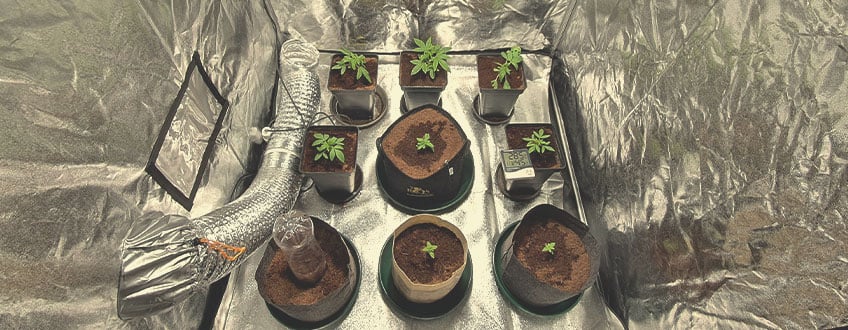
3. Water Consumption
According to a 2015 article[2] published in the journal BioScience, a single cannabis plant grown in California outdoors or in greenhouses between June and October consumes roughly 22 litres of water per day. Now, plants grown indoors for personal use obviously don’t consume nearly as much water. Nonetheless, these figures highlight just how much of an environmental impact cannabis cultivation can have, especially on a commercial scale.
The amount of water your plants require will change dramatically depending on the temperature of your grow room, the strain you're growing, and the health and size of each plant. Either way, improving water usage in your grow room is key if you want to grow sustainably.
4. Waste Management
Growing cannabis, like any other gardening or farming process, produces both organic and non-organic waste. Regardless of how big or small your grow-op is, it’s your responsibility to deal with this waste responsibly.
For commercial growers in legal markets, this oftentimes involves looking to third parties. In the US, for example, GAIACA is the country’s first fully licensed cannabis waste solutions provider.
Thankfully, for the home grower, managing cannabis waste is a lot simpler. Any organic waste, like plant material left over post-harvest, can go straight into your compost bin. There are also simple ways to reuse your old soil.
Dealing with nutrient runoff, on the other hand, can be a little more tricky. If it’s a small amount of runoff, you should dilute it and use it on other plants in your garden. If it’s more significant, using desalination and reverse osmosis systems can help you reclaim some of that water.
Ready to enhance your grow? Download our guide for essential tips on better cannabis cultivation!
Free RQS
Grow Guide!

How to Grow Cannabis Sustainably at Home
As we’ve learned, whether you’re a commercial supplier or a novice home-grower, sustainable growing practices are in your best interest. Here are a few ways you can make your cannabis grow more environmentally conscious.
Optimise Airflow
This step is very simple, but it can have a really impressive impact on your grow room’s energy efficiency. Improving air circulation benefits your plants by:
- Regulating temperature and humidity fluctuations.
- Preventing build-up of stagnant, CO₂-depleted air, which causes nutrient lockout and attracts pests and mold into your grow room.
- Mitigating the heat generated by your grow lights.
Optimising air circulation in your grow room is pretty simple. Ideally, you want your plants to constantly receive a soft, comfortable breeze both above and below their canopy.
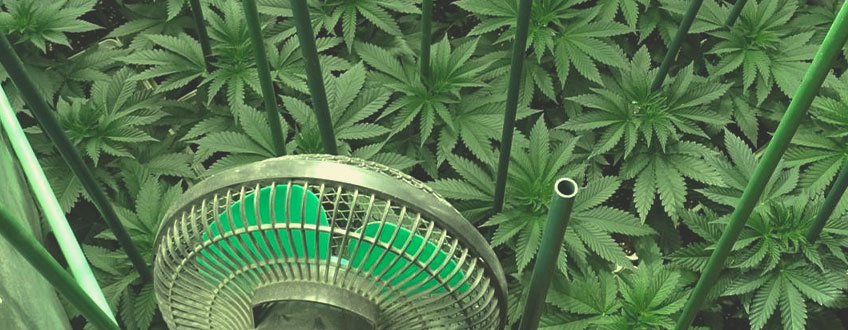
In a small setup like a grow tent, a simple clip-on fan attached to one of your walls or supports is usually enough to keep air gently moving around your plants. In larger rooms, however, you’ll want to invest in more powerful floor or wall-mounted fans. You may also need to use multiple fans to direct airflow around your plants.
Besides those fans, some growers purchase exhaust systems to remove hot, stagnant air from the room, replacing it with fresh air from outside. These systems include an exhaust fan, ducting, and a carbon filter that reduces the smell of air being expelled from your growing area.
For smaller grow rooms, you can use passive intake systems. Rather than using exhaust fans (which run on electricity), passive intake systems use ports that naturally allow fresh air to move into the grow space.
In a small indoor tent, 1–2 ports and a small fan can properly circulate air without constant exhaust fan operation. Larger setups, however, need more airflow, and therefore require an active exhaust system.
Save Water and Recycle
Another simple way to minimise the environmental impact of your grow room is to be more conscious of your water usage. There are a couple of ways to do this:
- Collect rainwater and condensation from your air conditioners.
- If you’re growing in soil, minimise runoff and use reverse osmosis to recycle any runoff that arises during watering.
- Mix perlite and vermiculite into your soil to improve water retention.
- If using hydroponics, sterilise and recycle the water from your system using one of these methods.
- Consider switching to hydroponics or aeroponics. Contrary to popular belief, these systems actually use less water than soil systems.
When trying to improve your use of water in the grow room, think about:
- Where your water comes from. Do you have the possibility to collect water from the environment or reclaim water from appliances in your household (such as the dishwasher, washing machine, or shower?)
- How much water you give your plants, and how much water they actually need.
- What to do with your water once it has left your plants.
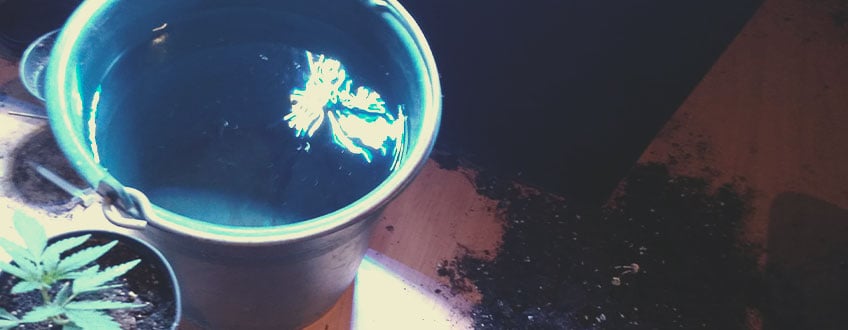
Make Organic Soil and Pesticides
Don’t get tricked into thinking that growing organic weed is any harder than the regular process. All it takes is an organic medium and a switch from chemical nutrients to natural fertilisers like guano or compost. And the results are definitely worth the minimal investment; organically grown weed boasts amazing flavors and aromas.
The foundation of great organic weed is, of course, great soil. Making your own organic super soil is super easy; just use organic starter soil and natural ingredients like perlite, worm castings, fishbone meal, and guano.
When it comes to fertilising your plants organically, we recommend using compost tea. While there are many ready-made options, you can make your own using compost, molasses, liquid kelp, and fish hydrolysate. Not only do they contain all the nutrients your plants need, but they also support microorganism growth in your soil, which, in turn, supports the growth of your plants and helps protect them against fungi and pests.
Yes, even when it comes to fighting pests, organics are on your side. Neem oil, for example, is a natural pesticide used to fight off spider mites, fungus gnats, leaf miners, and more. You can also make your own insecticides using equal parts vegetable oil and natural soap diluted in water. You can spray this mixture onto insects, or on infested plant leaves, but make sure you don’t spray your buds.
Alternatively, blend 2 bulbs of garlic, ½ cup of vegetable oil, 1 teaspoon of natural soap, and water. With that, you’ll have your own insect repellent.
Finally, utilising ladybugs, spiders, and microorganisms (like those found in organic soil) is one of the best pest handling methods. Combine friendly insects, neem oil, and natural insect repellent, and you’ll combat even some of the toughest cannabis pests.
Use a Combination of Artificial and Natural Light
If you want to get even greener, substitute artificial light for the real thing whenever possible. Obviously, the amount of natural light you can give your plants will vary greatly depending on where you live, along with the growing season.
If you’re growing in winter, for example, you may only be able to give your plants a couple of hours of natural light per day. But even so, turning off your grow lights for a couple of hours can make a sizable dent in your electricity consumption and even your power bill.
Here are some ways to make use of natural light as an indoor grower:
- Keep your seedlings or clones on a windowsill. Young, fragile plants love indirect and soft light.
- Move plants into a nice, sunny outdoor spot (if your climate permits it, of course).
- If your grow room has large windows that receive direct sunlight, utilise them. Only turn on your grow lights once the sun has gone.
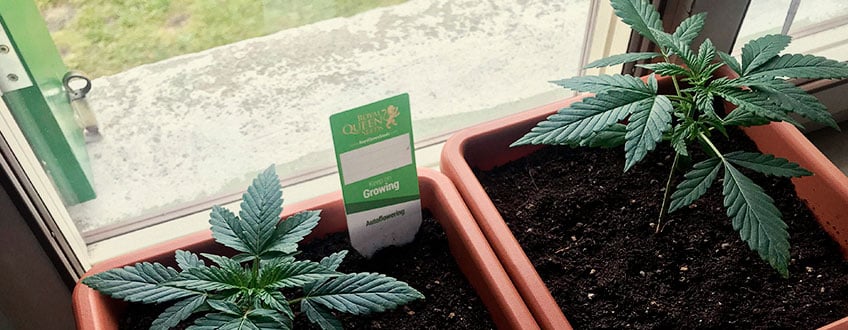
Utilising AI and Automation
While it might seem futuristic, many growers already capitalise on automation and AI in the grow room. In most cases, growers use automation to turn things on and off at the right times. This usually involves:
- Automating your grow lights to stay on an 18/6 or 12/12 cycle.
- Automating your air conditioners and humidifiers/dehumidifiers to turn on when the temperature and humidity in your grow room fall outside their optimal levels.
- Automating your ventilation system (exhausts and fans).
- Automating CO₂ supplementation (if you’re using it).
- Automating nutrients using auto dosers.
Automating your grow is pretty simple; it just involves the right equipment. For most hobby growers cropping just a few plants at a time, it’s simply a matter of using a timer to control your lights and fans.
Intermediate growers with slightly more space might also consider looking into temperature and humidity controllers. Large-scale growers, accordingly, invest in multi-function grow room controllers that manage temperature, humidity, lighting, and CO₂ all at once.
3 Sustainable Ways to Power Your Cannabis Grow
As we mentioned earlier, powering your grow lights and other equipment is responsible for a big part of your grow’s environmental impact. Luckily, there are sustainable ways to power your cannabis grow and reduce your grow room’s carbon footprint.
Solar Panels
More people are using solar panels to power their households than ever before. While it isn’t as common, it is definitely possible to power your indoor grow room with solar energy.
Pros:
- Any extra energy you produce cycles back into the grid, lowering your power bill.
- Readily available and easy to instal.
- Some governments offer incentives to households using solar electricity, such as tax credits.
- If electricity is expensive for you, a solar-powered grow room can save you lots of money in the long-run.
Cons:
- The main con of using solar energy is the initial investment. The panels themselves, and their installation, cost a few pretty pennies. That cost is especially intimidating if you’re only growing a few plants in a small room every year. Keep in mind, however, that you’ll essentially get that money back over time in electricity savings.
- If you live somewhere that doesn’t get enough sunshine, it might not be efficient.
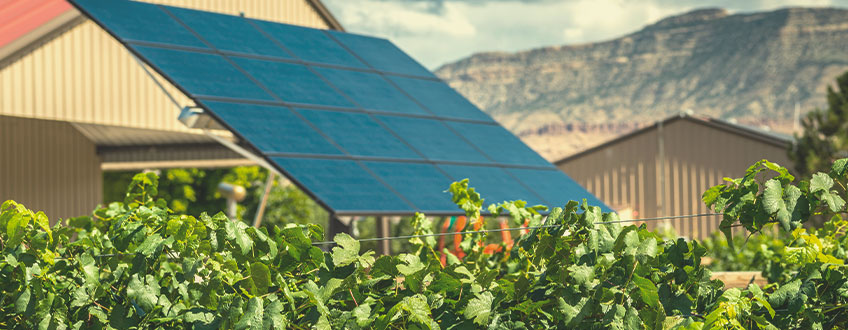
Wind Power
Wind power is another great energy alternative. While the phrase evokes images of massive turbines in fields, there are small, scalable versions available for personal use. You might be surprised to learn wind turbines can come at much lower prices than solar panels. Nonetheless, they also come with their own list of pros and cons.
Pros:
- Turbines are cheaper than solar panels.
- They’re great at generating energy in areas without a lot of sunshine.
Cons:
- Regardless of their size, they require a lot of space.
- Turbines are almost impossible to hide if you’re trying to keep your growing operation secret.
Hydropower
Finally, one of the best sources of renewable, clean energy is hydropower. And while it’s a bit location-specific (you need access to a stream of water), hydropower generators are pretty cost-effective. In fact, you can even build one yourself[3] for a fraction of the cost of a ready-made hydroelectric generator.
Pros:
- Uses natural, renewable resources.
- Saves money in the long-run.
Cons:
- Home hydropower systems can be expensive outright, depending on the scale of the operation.
- Requires access to nearby water source.
Saving the Environment, One Seedling at a Time
Regardless of the size of your grow room, all of these simple, sustainable growing adjustments are well within reach. Even if you’re not able to do everything we’ve listed here, even one adjustment can make a big difference. Both your local environment and your plants will thank you, not to mention your wallet!
- Growing Marijuana Uses 1 Percent of America’s Total Electricity, Industry Says https://www.vice.com
- High Time for Conservation: Adding the Environment to the Debate on Marijuana Liberalization https://www.ncbi.nlm.nih.gov
- DIY: Make Electricity Using Your Backyard Stream - The Green Optimistic https://www.greenoptimistic.com








































